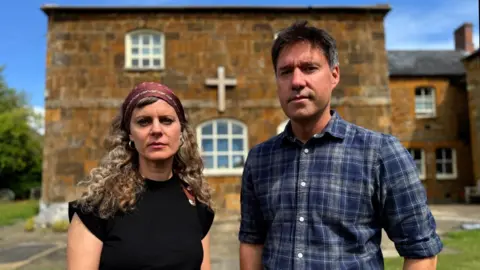The investigation into one of the most notorious and abusive cults in the UK, known as the Jesus Army, has unveiled a disturbing legacy of trauma and exploitation affecting hundreds of individuals. This article highlights the findings of journalist Jon Ironmonger, who dedicated years to uncovering the truth behind the Jesus Fellowship, a movement that appeared as a joyful church community in the tranquil Northamptonshire countryside but operated under a facade that masked horrific acts of abuse.
Initially, the Jesus Army seemed harmless, characterized by enthusiastic worship, vibrant military-style uniforms, and a significant following of two to three thousand members. However, Ironmonger’s journey began in earnest in 2016 when alarming reports surfaced about suspicious practices within the cult, including unexplained deaths, such as a young man found deceased on railway tracks. It was a chance encounter with a woman at St Pancras Station that led to the shocking discovery of the cult’s extensive history of abuse, where initial estimates of victims ranged into the hundreds.
As Ironmonger delved deeper, he uncovered a systematic pattern of abuse and cover-ups that permeated the leadership of the Jesus Fellowship. Following extensive interviews and investigations, the BBC presented findings that exposed child abuse and the ongoing complicity of the church’s senior figures. The organization officially disbanded a year later.
Ellena Wood’s documentary, “Inside the Cult of the Jesus Army,” brings further illumination to this tragic narrative. She began her investigation in 2022 and spoke to over eighty survivors, family members, and relatives, culminating in a gripping two-part film that chronicles the survivors’ harrowing experiences. Wood emphasized that many had never shared their traumas and were still grappling with the emotional aftermath of their involvement with the cult.
One poignant aspect highlighted by Wood is the ambiguity that many victims feel regarding their abuse; they often do not recognize it as such and frequently blame themselves instead. The film aims to convey the long-lasting impact of cult life, which extends well beyond the act of leaving – shaping decisions, relationships, and personal guilt.
The emotional toll on both survivors and filmmakers has been substantial. Wood, who became a mother during the production process, described the difficulty of immersing herself in such painful narratives while navigating her own new family life. She noted the intense connections formed during interviews, filled with emotional exchanges and the heavy burdens borne by survivors.
In the wake of the Jesus Army’s disbandment, revelations about its founder, Noel Stanton, and his “apostles” have emerged, disclosing a culture of secrecy that shielded abusers while punishing victims. One former elder branded Stanton as a “predatory paedophile,” revealing an alarming history of sexual assaults swept under the rug before his passing in 2009.
Ellena Wood has suggested that the Jesus Army may have transitioned from an admirable excitement for spirituality into sinister control driven by Stanton’s insatiable need for power. While acknowledging that experiences within the cult were not universally negative, she pointed out that many victims suffered profoundly traumatic experiences.
Highlighting the complexities of the survivors’ experiences, the documentary captures moments of vulnerability and realization. One particularly moving scene involves David, a former elder, emotionally grappling with the reality of the abuse victims faced in the church, marking a significant moment of acknowledgment and accountability.
In a recent statement, the Jesus Fellowship Trust, now in the process of dissolving, expressed its horror at the abuse and extended an unreserved apology to those affected. A compensation fund was created, resulting in average payouts of around £12,000 to each victim, illustrating a small step towards healing.
The BBC’s documentary “Inside the Cult of the Jesus Army” is set to air on BBC Two, accompanied by a podcast detailing the cult’s systemic abuse and the implications for those who suffered within it. Both initiatives aim to shed light on these hidden horrors, ensuring that the voices of the survivors are heard and recognized.
In conclusion, the work of Ironmonger and Wood serves as a sobering reminder of the hidden dangers often lurking behind the veneer of religious movements and the urgent need for a societal dialogue addressing the impact of such organizations on vulnerable individuals.












